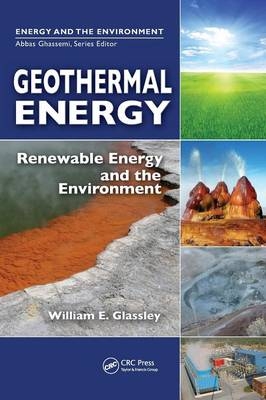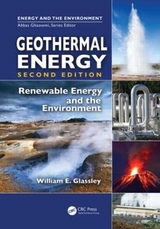
Geothermal Energy
Crc Press Inc (Verlag)
978-1-4200-7570-0 (ISBN)
- Titel erscheint in neuer Auflage
- Artikel merken
Historically, cost effective, reliable, sustainable, and environmentally friendly, use of geothermal energy has been limited to areas where obvious surface features pointed to the presence of a shallow local heat source, such as hot springs and volcanoes. However, recent technological advances have dramatically expanded the range and size of viable resources, especially for applications such as modular power generation, home heating, and other applications that can use heat directly. These recent developments have greatly expanded opportunities for utilizing geothermal energy. Reflecting current interest in alternative energy, Geothermal Energy: Renewable Energy and the Environment explores where geothermal energy comes from and how to find it, how it can be accessed, successful applications, and improvements for future uses.
The author reviews the background, theory, power generation, applications, strengths, weaknesses, and practical techniques for implementing geothermal energy projects. He stresses the links between acquisition and consumption and the environment. Packed with real world case studies and practical implementation steps, the book covers geosciences principles, exploration concepts and methods, drilling operations and techniques, equipment needs, and economic and environmental topics. Each chapter includes an annotated list of key sources that provide useful information beyond that contained in the text.
The minor environmental impacts caused by geothermal energy gives it the potential to play an important role in the transition from fossil fuels to more sustainable fuels. Successful deployment, however, requires that the resource be matched to the application being developed. Rigorously covering all aspects of geothermal energy, this book provides up-to-date scientific information that can be used to discern applications and regions best suited for geothermal energy.
Author William E. Glassley was recently interviewed on The Kathleen Show about using geothermal energy to heat and cool our homes.
The Energy Institute, University of California, Davis, USA Geologisk Institut, Aarhus University, Aarhus, Denmark
Introduction
The Global Energy Landscape
Geothermal Energy as a Renewable Energy Source
Electrical Demand and the Characteristics of Geothermal Energy
How This Book is Organized
Synopsis
Further Information Sources
References
Sources of Geothermal Heat: Earth as a Heat Engine
Origin of Earth’s Heat
Transfer of Heat in the Earth
Plate Tectonics and the Distribution of Geothermal Resources
Availability and Utilization of Geothermal Energy
Synopsis
Case Studies
Further Information Sources
References
Thermodynamics and Geothermal Systems
The First Law of Thermodynamics: The Equivalence of Heat and Work and the Conservation of Energy
The Second Law of Thermodynamics: The Inevitable Increase of Entropy
Gibbs Function and Gibbs Energy (ΔG)
Thermodynamic Efficiency
Case Study: The Thermodynamic Properties of Water and Rock–Water Interaction
Synopsis
Further Information Sources
References
Subsurface Fluid Flow:—The Hydrology of Geothermal Systems
A General Model for Subsurface Fluid Flow
Matrix Porosity and Permeability
Fracture Porosity and Permeability
The Effect of Depth on Porosity and Permeability
Hydrologic Properties of Real Geothermal Systems
Case Study: Long Valley Caldera
Synopsis
Further Information Sources
References
Chemistry of Geothermal Fluids
Why the Geochemistry of Geothermal Fluids Matters
Water as a Chemical Agent
Components and Chemical Systems
Saturation and The Law of Mass Action
The Kinetics of Geothermal Reactions
Gases in Geothermal Fluids
Fluid Flow and Mixing in Natural Systems
Simulating Reactive Transport
Case Study: The Silica System
Synopsis
References
Exploring for Geothermal Systems
Field Geology and Surface Manifestations
Geochemistry as an Exploration Tool
Geophysics as an Exploration Tool
Remote Sensing as an Exploration Tool: A Promising New Technique
Case Study: Fallon, Nevada
Synposis
Further Information Sources
References
Resource Assessments
Assessing a Geothermal Resource
Resource Base and Reserves
Establishing the Reservoir Volume
Establishing the Reservoir Heat Content
The Significance of Heat Capacity
Efficiency of Heat Extraction
A Case Study: Establishing the United States Geothermal Resource
Synopsis
Further Information Sources
References
Drilling
Background
Drilling for Ground Source Heat Pump and Direct-Use Applications
Drilling for Geothermal Fluids for Power Generation
Confining Pressure and Rock Strength
Case Study: Kakkonda, Japan
Synopsis
Further Information Sources
References
Generating Power Using Geothermal Resources
The History of Geothermal Power Production
General Features of Geothermal Power Generation Facilities
Dry Steam Resources
Hydrothermal Systems
Binary Generation Facilities: The Organic Rankine Cycle
Case Study: The Geysers
Synopsis
Further Information Sources
References
Low Temperature Geothermal Resources: Ground Source Heat Pumps
Basic Heat Pump Principles
The Thermodynamics Of Heat Pumps
The Near-Surface Thermal Reservoir
Design Considerations for Closed-Loop Systems
Case Study: Weaverville
Synopsis
Further Information Sources
References
Direct Use of Geothermal Resources
Assessing the Magnitude of the Direct Use Reservoir
The Nature of Thermal Energy Transfer
Establishing the Feasibility of a Direct Use Application
District Heating
Aquaculture
Drying
Case Study: Canby Cascaded System
Synopsis
Further Information Sources
References
Use of Geothermal Resources: Environmental Considerations
Emissions
Solute Load and Resource Recovery
Ground Subsidence
Water Use
Land Use
Synopsis
Additional Information Sources
References
Use of Geothermal Resources: Economic Considerations
Economics of Geothermal Power
The Economics of R&D Investment in Geothermal Energy
Developing a Geothermal Project
Synopsis
References
The Geothermal Energy Future: Possibilities and Issues
Geopressured Resources
Enhanced Geothermal Systems (EGS)
Synopsis
Further Information Sources
References
Index
| Erscheint lt. Verlag | 30.6.2010 |
|---|---|
| Zusatzinfo | An 8-page color insert containing 16-color figures follows page 156; 171; 33 Tables, black and white; 149 Illustrations, black and white |
| Verlagsort | Bosa Roca |
| Sprache | englisch |
| Maße | 178 x 254 mm |
| Gewicht | 771 g |
| Themenwelt | Technik ► Elektrotechnik / Energietechnik |
| ISBN-10 | 1-4200-7570-5 / 1420075705 |
| ISBN-13 | 978-1-4200-7570-0 / 9781420075700 |
| Zustand | Neuware |
| Haben Sie eine Frage zum Produkt? |
aus dem Bereich



